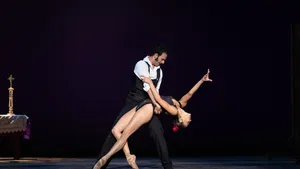Stay in the Loop
BSR publishes on a weekly schedule, with an email newsletter every Wednesday and Thursday morning. There’s no paywall, and subscribing is always free.
A well-known story with a sexy edge
The Philadelphia Ballet presents Angel Corella’s Carmen

To open the Philadelphia Ballet’s 60th season, artistic director Angel Corella celebrates his Spanish culture with the world premiere of his first original long-form ballet, Carmen, based on the opera of the same name. We all know the story: Carmen, a Sevillian working girl, slashes a coworker with a knife. She gets arrested but seduces a guard, Don José, into setting her free. Now jobless, she turns to prostitution. Jealous when his commanding officer has sex with her at the brothel, Don José kills him in a duel and runs for the hills. In Act II, Carmen takes up with the local toreador. Cue more sex, more jealousy, and (spoiler) because this is a ballet based on an opera, everybody dies.
Corella has been planning for this day since he arrived in Philadelphia. Both the composer, Georges Bizet, and Prosper Mérimée, who wrote the original novella, were French, but in a Zoom presentation, Corella said that Spain has always embraced the opera as its own. In Carmen, he combines the Flamenco he learned as a boy and the Sevillanas danced at every celebration with classical ballet. Dancers perform classical steps with a rolling shift of a hip or shoulder, the turn of a leg, or an upraised arm curled slightly ahead of the body, blending seamlessly with Spanish steps re-visioned just enough in classical style. It gives the piece an edge of tension heightened by the musical choices.
Love and murder
Carmen opens with Don José (Arian Molina Soca) in high-waisted black pants and a white shirt on a set of rolling screens to imagine a cell. Lighting designer Nick Kolin creates the shadows of prison windows overhead, and a drum and castanets warn of doom. Don José’s anguish is palpable as Soca rises from a bench and strikes a pose with power in his angled arms. He stretches out to one knee and leaps into a split handstand off the bench. A woman in Flamenco ruffles stands in shadows on the other side of the wall. The scene starkly foreshadows the tragedy to come.
The story, in flashback, begins with the women of the corps in tutus with gold tops and green and red skirts. They sit behind a worktable, beating their hands on it to echo the castanets. Then Nayara Lopes, in Carmen’s trademark red, flies onto the scene in a glorious jeté, exploding with firebrand energy. Carmen is all about the sex and the violence, and we are here for it: the fight, the arrest, the seduction.
The bedroom scene between Soca and Lopes, set to the opera’s Intermezzo, gives us heated sex one moment and swooning lyricism the next, as Soca turns with Lopes, almost bonelessly supple, draped across one arm. We’ll come back to that later.
But Carmen has lost her old job. In a cascade of pink ruffles, she flaunts her fallen status. The disapproving townsfolk in long peasant skirts and shawls seem like too many people in too much cloth on the stage here, though they can’t distract from the gnarly, up-against-the-wall sex scene with Sterling Baca as the general. In a jealous rage, Don José kills him, while a death-knell drumbeat reminds us of the prison cell that awaits.
Love and murder, Act II
Act I has great moments, but Act II is a standout. Hiding out in the hills, Don José and the bandits give us displays of manly braggadocio with prancing leaps and crossed ankles, a moment of gaiety amidst tragedy. For the bullfight, screens create the arena, with the head of a bull reflected in red light above it. Jack Thomas as Escamillo, in white that evokes a suit of lights, has a bombastic dance full of upcurved arms and drops to the knee. The women of the corps, in the sleek black lace of the demi-monde, show their approval by snapping their red fans like castanets, and the men circle the stage in grand jetés usually reserved for a bravura solo. The tight formation at the end gives the scene a cabaret sensuality as Carmen seduces Escamillo.

Lopes dances Carmen as a challenge, with all the recklessness that defines the role. She’s a girl who likes to be on top—only the paying customers get that privilege—and her encounters with her three partners are profoundly sexual in the steamiest, most destructive way. The finale is full of echoes tying it all together, but now, even the costumes are dark. Don José murders Escamillo while the drum that has ridden all of his disasters beats another knell. His scene with Carmen brings back the Intermezzo, and that lift with her draped in one arm is now punctuated by her futile efforts to escape.
At a bit over an hour, the ballet drives us headlong through Carmen’s disastrous life and Don José’s fall into obsession. But it takes time to let the male dancers, in particular, shine.
What, When, Where
Carmen. Choreography by Angel Corella. Philadelphia Ballet. $22-$215. October 5-15, 2023, at the Academy of Music, 240 S Broad Street, Philadelphia. (215) 893-1999 or philadelphiaballet.org.
Accessibility
The Academy of Music is part of the Kimmel Cultural Campus and is an ADA-compliant venue.
Sign up for our newsletter
All of the week's new articles, all in one place. Sign up for the free weekly BSR newsletters, and don't miss a conversation.

 Camille Bacon-Smith
Camille Bacon-Smith